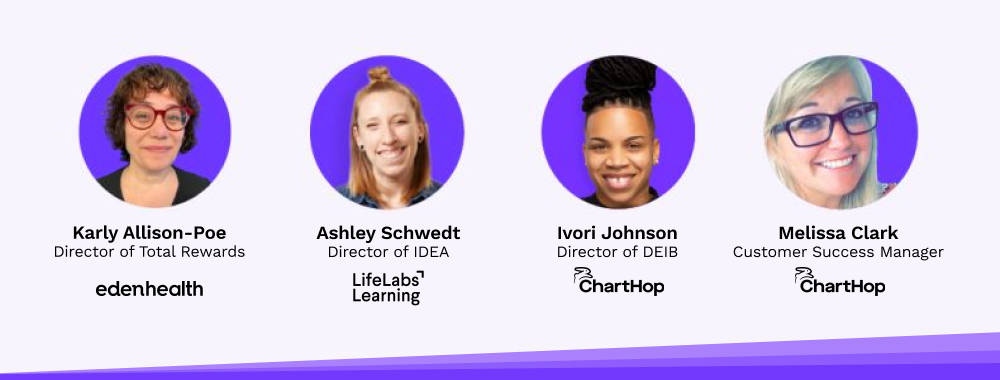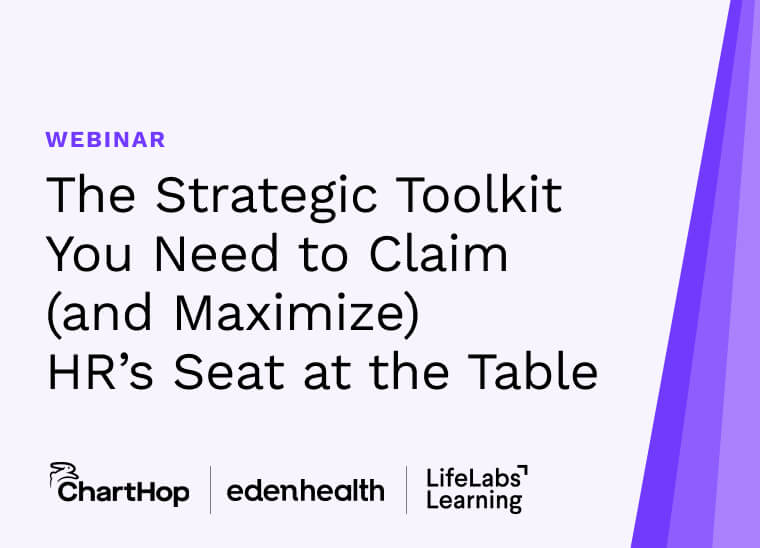In the workshop, HR leaders shared their lessons on how to:
- Hone strategic thinking skills to elevate the craft of HR
- Improve decision-making company-wide
- Understand and interpret people data to draw actionable insights
- Align the wants and needs of employee populations with core business objectives
Virtual panel featuring:

If you couldn’t join the webinar live, you can watch the full panel discussion, or we’ve recapped some of the panelists’ most important advice below.
Understand and Interpret People Data to Draw Actionable Insights
Every HR professional knows the importance of collecting and analyzing data from their people to measure employee performance and engagement. Despite, or maybe because of, the importance of this data, it can be intimidating.
Johnson from ChartHop is no stranger to manual data collection, but without a way to synthesize that information it becomes difficult to notice and act on trends within an employee population. She recommends keeping the information on one platform, like ChartHop, where you have the ability to look at employee life cycles, including promotions and compensation plans, to analyze that data in an intersectional way.
Schwedt from LifeLabs Learning emphasizes data’s ability to support trends HR teams might already be aware of, but it can illuminate themes or problems they didn’t know existed.
How to Get Leadership Support to Drive Initiatives
HR professionals have access to the right data, but it’s difficult to know how to utilize it correctly to make sure executive leaders are making an impact. Allison-Poe from Eden Health urges HR leaders to start simply — form a relationship with executives to gain an understanding of where their values coincide with employee needs, and the business will ensure the foundation is set up for alignment.
By presenting problems and solutions in a way that has a clear impact on higher-level priorities, Schwedt and Johnson agreed it’s possible to by-pass the “what’s-in-it-for-me” roadblock that often comes up when pitching to executive teams. HR leaders should present data as a story that demonstrates how a problem is going to affect the business, along with a solution. According to Schwedt, helping senior leadership by linking and contextualizing problems within an organization that are highlighted through data “matters because of the impact on our company culture, our mission, the cost of turnover.”
The Correct Cadence for Reviewing Data
Allison-Poe acknowledges that data analytics have come a long way in a short period of time. Identifying the right cadence where the information gathered becomes the most useful will ensure HR teams are meeting the needs of their company for things like compensation and diversity and inclusion.
Schwedt suggests looking at annual trends to create an action plan for the entire year, giving teams time to actually make movement on them. Quarterly meetings and smaller check-ins should be included throughout the year to judge the progress of the overall goals. Johnson spoke to the importance of monthly check-ins with key stakeholders, like the CEO.
More important than determining the cadence for building plans is the follow-through of said plans. Setting achievable goals with realistic timing is crucial for retaining the trust of an organization’s workforce. Engagement surveys should serve as the foundation for action plans and employees then want to see results from their participation.
How the HR Role Has Shifted Over Time
There is no question there has been a shift in the human resources role within companies across all different industries over the past few years. Their responsibilities have expanded and they have access to more and more information.
People teams have become more focused finding the definition of “belonging” in the workplace. Johnson wants HR leaders to be smart about what diversity, equity and inclusion (DEI) actually is. Schwedt acknowledges, “Companies have been asking people to give a lot of themselves to the company.” Leaders have to measure the impact of that request across different groups within an employee population.
Allison-Poe spoke to the shift away from executives consulting HR leaders exclusively on compensation. The overall well-being and culture of an organization only improves when there is buy-in from senior leadership on the must-haves beyond employee pay. Employees want to know that their company cares for them. Companies can create parity within the workplace by offering benefits that actually meet the needs of their population and those that are most impacted by certain issues. Looking at engagement by cross-analyzing demographic data, HR leaders are better able to create an inclusive workplace because they can understand what their employees are feeling and thinking based on their backgrounds.
Strategic Thinking: Improve Decision Making Company-Wide
Schwedt wrapped up the panel by giving some insights into a more extensive LifeLabs Learning Workshop. The workshop is centered around using strategic thinking, which can be defined as keeping the future in mind when taking action in the present, all while considering the complexities of the situation. Schwedt touched on two of the five habits that matter most when improving this skill set for you and your workforce: the Gap Check and the Lens Check.
The Gap Check forces you to begin with the end in mind. If you know where you are starting from and where your end goal is, you can understand how far you have to go and how to measure progress. Taking action boosts motivation, especially when your objective is clear.
The Lens Check illustrates the different lenses that could be impacting a certain situation. This crucial check-in helps avoid the fundamental attribution error. This is where problems are inappropriately attributed to one individual when it could actually be caused by a multitude of factors. When the Lens Check is properly executed, leaders can understand where they can make an impact and create processes to overcome converging issues.
Offer Better Benefits Your Executive Team Will Notice
By understanding the needs of your employees through people data and strong strategic thinking skills, you can more confidently bring your seat to the table. If you are looking to present a strong case for improving the wellbeing of your employees to your leadership, our team of experts is here to help. Contact us or request a demo today to learn more about providing better care for your workforce and how your organization can benefit from a partnership with Eden Health.





